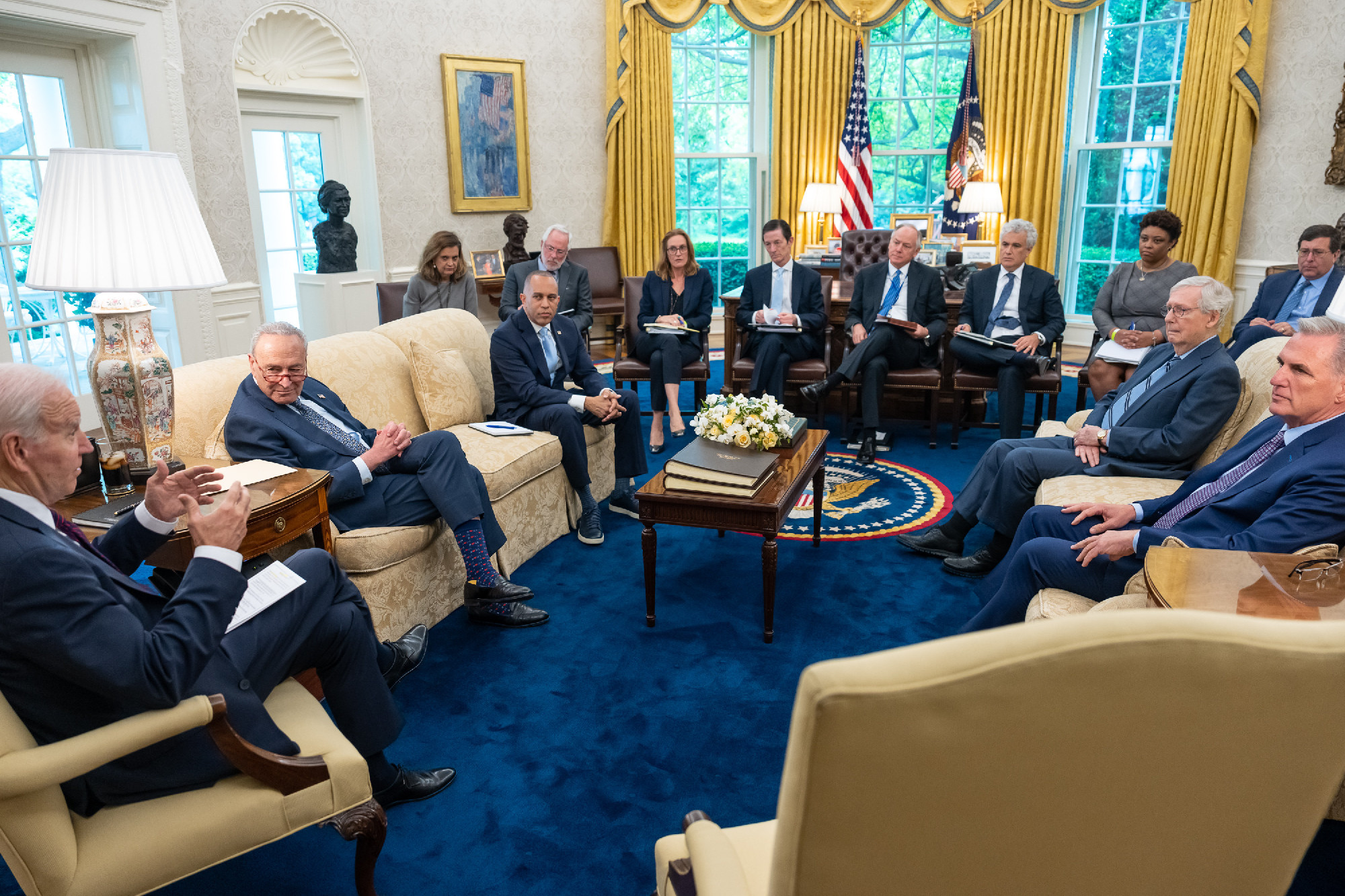More recently, President Biden agreed to have his staff meet directly with House Speaker Kevin McCarthy’s aides, with the result that the two sides have come to a deal. In the deal reached on Sunday, they did not raise the limit to a certain level but suspended it entirely until 2025. This allows the U.S. government to pay its bills until that date and know that the next fight over raising the ceiling will not interfere with the presidential election. Next, Congress will need to approve this package prior to June 5, the date when the U.S. government will not be able to finance its obligations. There were both Democrats and Republicans who were not happy with certain portions of the deal, so approval was far from a certainty.
The Sunday Deal
The key parts of the deal included an agreement to keep non-defense spending flat next year, with a 1% rise in 2025. There are no budget caps after 2025. Also, $30 billion in unspent COVID funding will be returned to the U.S. Treasury. A central demand of Republicans was to toughen up the distribution of welfare benefits by attaching strings that would mean able-bodied recipients having to work to get food and healthcare help. Democrats were adamant this should not be on the table. While health benefits to poorer Americans remained untouched, the age at which work requirements are included for those on other welfare programs was raised from 50 to 54.
Hard to Swallow
During the negotiations, Republicans demanded that any deal include stricter work requirements for social safety net programs. Biden hinted that he might be willing to accept such a bargain, drawing a backlash from liberal congressional Democrats, who began openly worrying that the President might agree to a deal they cannot accept. The pushback reflected the political crosscurrents at play in the talks between Biden and McCarthy, both of whom had to contend with slim majorities in Congress and uncompromising political bases that would find any agreement hard to swallow.
What if?
What are the consequences if Senate does not (though both caucus leaders expect it to) approve the debt ceiling deal reached last Sunday? If not passed, the government may run out of money as early as June 5. If that were to occur, the government would no longer be able to pay its bills, and potentially default on its debts. Such a situation could send the financial markets, and the economy, into chaos. “We are sailing into uncharted waters,” one expert said.
The debt ceiling is the legal cap that Congress sets on the amount that the Treasury can borrow. It does not authorize any new spending; it simply lets the government pay for what Congress has approved. The debt ceiling came into being in 1917; before then, Congress tended to authorize borrowing for specific purposes. But when raising money to support America’s entry into the first world war, Congress granted the Treasury more flexibility, eventually setting a comprehensive debt ceiling in 1935.
The Main Issues of the Deal
For many years, raising or adjusting the debt limit was a pro forma congressional function. Since 1960, it has done so 78 times: 49 times under Republican presidents, and 29 times when a Democrat was in the White House. During Donald Trump’s presidency, a bipartisan congressional majority raised the ceiling three times, and Democrats agreed to a two-year suspension of the ceiling as part of a budget agreement in 2019.

White House staff watch the Senate vote on raising the debt limit on 2 August 2011
As part of an effort to avoid a default, congressional negotiators met over the past several weeks. The negotiators narrowed their focus to a smaller group of key issues that were ripe for compromise. Late last week, House Speaker McCarthy said, “we’re getting closer.” He added that the “circle” of issues was becoming “smaller, smaller, smaller.” At that time, the issues on the table included reforms to energy permitting, new work requirements for some forms of federal aid and the redistribution of unused COVID-19 emergency funds – all of which were addressed in the deal.
Cutting Spending
Most importantly, Republican negotiators pushed for future government budget caps to be put in place to contain spending and bring down the U.S. national debt. “The fundamental issue here is spending. This is not about gamesmanship,” said negotiator and Representative Patrick McHenry outside the headquarters of the Republican National Committee. “This is about us getting a deal before the deadline that meets the Speaker’s message that we’re spending less money next year than we’re spending now.”
Biden got what he wanted with next debt limit deadline pushed out past the 2024 presidential election, without agreeing to some of the further spending cuts endorsed by many Republicans in Congress. That said, congressional Democrats are concerned about the provision in the deal of tightening the requirements for some government aid recipients. Biden remained opposed to changes in requirements for recipients of Medicaid and food stamp programs, but he and his negotiators had to compromise on revisions in some cash assistance programs.
The idea of imposing more work requirements was resoundingly rejected by House Democrats, according to one representative. Democratic lawmakers from the liberal wing of the party have raised the issue. Rep. Pramila Jayapal, the chair of the Congressional Progressive Caucus, said, “We want to make sure that these negotiations do not include spending cuts, do not include work requirements, things that would harm people across the board.” That said, a separate group of more centrist Democrats signaled to their moderate Republican colleagues they are prepared to work something out to reach a debt ceiling deal.
Global Consequences
In the event the government runs out of funds, the Treasury would have to either default on payments to bondholders or immediately curtail payment of funds owed to various companies and individuals that had been mandated but not fully funded by Congress. Both situations would be expected to result in a global economic meltdown. Additionally, if the federal government was unable to issue new debt, it would have to balance its budget by imposing budget cuts that, in total, would equal 5% of the size of the American economy. Such an occurrence would have global economic ramifications.
The author is a senior fellow at the Institute for American Studies at the University of Public Service, Budapest
Opening picture: President Joe Biden meets with Senate Majority Leader Chuck Schumer (D-NY), Minority Leader Mitch McConnell (R-KY), House Speaker Kevin McCarthy (R-CA) and House Minority Leader Hakeem Jeffries (D-NY) to discuss the debt ceiling on 9 May 2023 in the Oval Office of the White House (photo by Adam Schultz)




